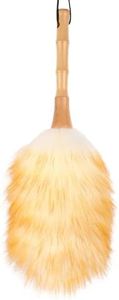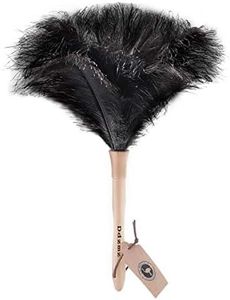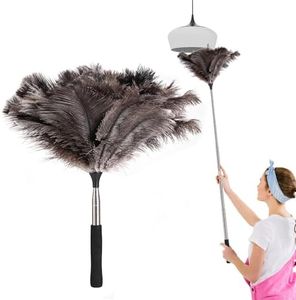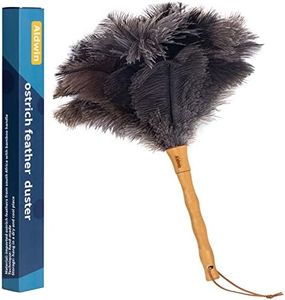We Use CookiesWe use cookies to enhance the security, performance,
functionality and for analytical and promotional activities. By continuing to browse this site you
are agreeing to our privacy policy
10 Best Feather Dusters
From leading brands and best sellers available on the web.Buying Guide for the Best Feather Dusters
Choosing the right feather duster is all about understanding your cleaning needs and the spaces you plan to maintain. Feather dusters are handy tools for removing dust from delicate surfaces, hard-to-reach areas, and decorative items that can't be easily wiped. Knowing the different features can help you select a feather duster that effectively collects dust without scattering it or causing damage.Feather TypeFeather type refers to the kind of feathers used in the duster, such as ostrich, chicken, or synthetic fibers. This matters a lot because different feathers attract and hold dust differently. Ostrich feathers are prized for their softness and ability to trap fine dust without leaving scratches, making them ideal for delicate surfaces and electronics. Chicken feathers are firmer and better for general dusting on less fragile items. Synthetic options are more durable and easier to clean but may not pick up dust as well. If you have lots of delicate or intricate items, softer feathers like ostrich are better; for tougher jobs, firmer feathers or synthetics may be best.
Handle LengthHandle length determines how easily you can reach high or awkward places. Short handles give you more control for close-up tasks, like dusting shelves or collectibles, and are lighter to use. Medium handles offer a balance—suitable for both nearby and moderately high spots. Long or extendable handles help you dust ceiling fans, tall cabinets, or chandeliers without a ladder. Choose a length based on the average height of the surfaces and objects you need to dust, keeping in mind your comfort and reach.
Feather DensityFeather density refers to how many feathers are packed into the duster head. High density means there are more feathers, making the duster fluffier and better at trapping dust in one pass. Low-density dusters are lighter and easier to maneuver into tight spots but may need more passes to clean well. For large or open surfaces, higher density is useful, while for small, detailed cleaning jobs, a lower density might be easier to work with and less likely to displace fragile pieces.
Ease of CleaningThis spec is about whether you can easily wash or shake out the feather duster to keep it clean for long-term use. Some feather dusters are washable (especially synthetics and high-quality ostrich types), so you can rinse them under water and let them air dry. Others may simply be shaken out, which is quicker but less thorough. If you’ll be dusting stuff that gets very grimy or if allergies are a concern, look for a duster that’s easy to wash and maintain.
Weight and Grip ComfortWeight and grip comfort describes how heavy the duster feels in your hand and how comfortable it is to hold, especially during extended cleaning. Lightweight dusters with ergonomic handles are easier to use for longer periods, reduce hand fatigue, and offer better control in tricky areas. Heavier dusters might provide more cleaning power but can be tiring. If you plan to dust for a while or have limited hand strength, aim for a lightweight option with a soft or non-slip handle.
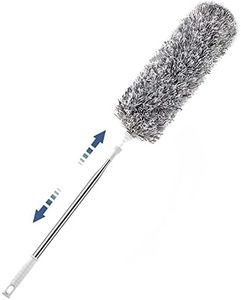
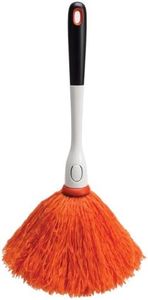
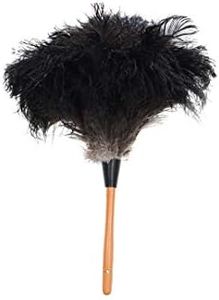
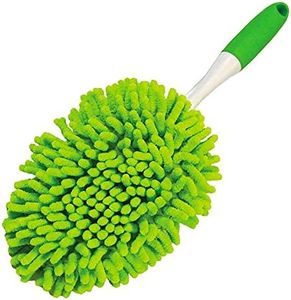
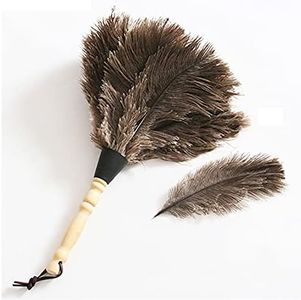
![[REDECKER / Redekka] Yes luxury dust of mountain wool (beating)](https://images-proxy.bestreviews.guide/bknqjEZ4Jsv6HsbUXCVr0OQQzVM=/0x300/https://m.media-amazon.com/images/I/31poYF7hc4L._AC_CX679_.jpg)
